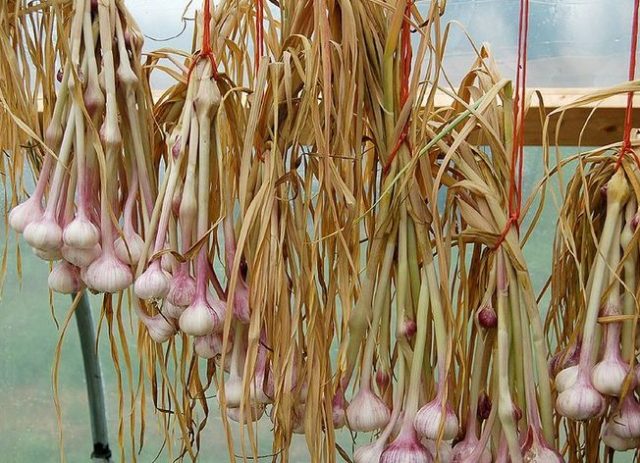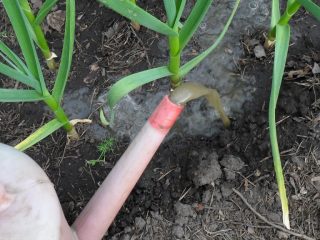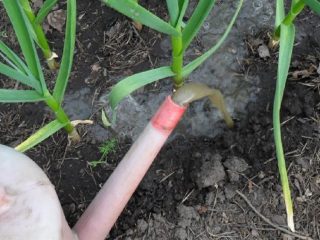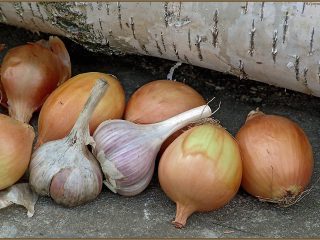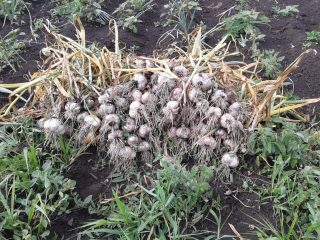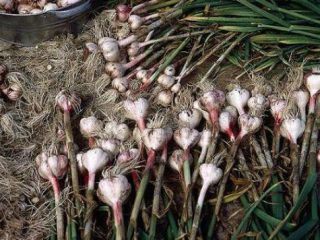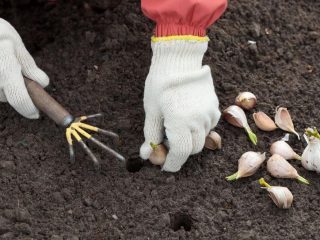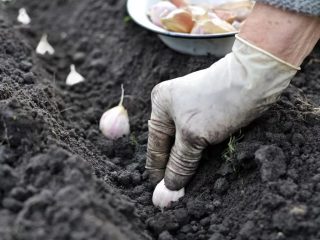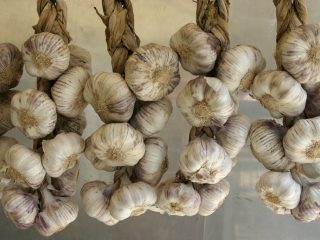Content
Winter garlic Parus: description of the variety, reviews and cultivation features will be of interest to gardeners in all regions. The variety was included in the State Register of Breeding Achievements of Russia in 1988.
History of selection
The Parus variety is an achievement of Soviet breeders. It was developed in Russia at the Federal State Budgetary Institution “Federal Scientific Center for Vegetable Growing”, which is located in the Odintsovo district of the Moscow region. Agronomists managed to obtain a high-yielding winter variety that is resistant to frost and disease. Winter garlic Parus can be grown in all regions of the post-Soviet space.
Detailed description
The shape of the bulbs of Parus garlic is round-flat; they consist of 6-8 cloves with dense, sharp-tasting pulp. The outer scaly cover is gray-white, the teeth are brown with purple streaks. The fibrous root system is located close to the surface; the plant needs regular watering, but does not like waterlogged soil.
Lanceolate, long leaves - about 1 cm wide, have a pointed end. A false stem is formed due to the growth of young leaf blades from the middle of old leaves.
The flower stalks are twisted into a spiral at the ends before flowering begins.In the inflorescence - an umbrella, covered with a thick wrapper, along with sterile flowers there are aerial bulbs - bulbs. Seeds do not form on garlic of the Parus variety.
Characteristics of the variety
The winter variety Parus is a mid-season, bolting variety. It takes 3-3.5 months from germination to full technical ripeness. The maximum height of the narrow long leaves is about 55 cm, the arrows are 2 times longer. The variety is distinguished by its yield, resistance to cold and disease, and excellent taste. The crop is suitable for growing in regions with harsh climates; it tolerates soil freezing down to -22 °C without harm to further vegetation.
Garlic of the Parus variety is propagated vegetatively - by dividing the bulbs and airy bulbs formed in the peduncles. The shoots of plants not intended for propagation must be promptly removed. Winter garlic is stored after harvesting in dry, cool rooms, at a temperature of +1... +3 °C. Planted in beds in September.
Productivity
One bulb of Parus garlic weighs from 30 to 47 g. With good care, 1 sq. m you can harvest up to 1.8 kg of crop. If the plot is not watered during the summer, the harvest will be 2 times less. The size of the bulbs is affected by the timely removal of growing shoots. If the arrows are not cut off, all the growth force will go to tying airy bulbs in the peduncles; the mass of the bulbs with arrows does not exceed 15-20 g.
Sustainability
Winter garlic Parus, according to gardeners, is well preserved and frost-resistant. Suitable for cultivation in all regions of Russia suitable for vegetable growing. In rare cases, it can be affected by downy mildew, stem nematodes or bacterial rot. Garlic of the Parus variety is not demanding in terms of care, but responds well to watering and fertilizing.
The harvested crop is perfectly stored throughout the year. Cloves planted in the fall give vigorous shoots in the spring. Preventive spring treatment of garlic beds with fungicides and insecticides helps to get a good harvest in July.
Advantages and disadvantages
The advantage of the variety is high yield, frost resistance, and good taste. Garlic Sail, shown in the photo, is suitable for growing in regions with harsh climates and is little affected by diseases. From planted bulbs you can independently obtain high-quality planting material. Disadvantages include the ability to shoot.
Planting and care
The Parus garlic variety is planted in fertile soil with a neutral reaction environment. On acidic soil you cannot expect a high yield. The culture does not tolerate close groundwater and shading. Poor predecessors for garlic are potatoes, onions and garlic itself. The crop grows well after legumes, cucumbers, zucchini, and cabbage.
The beds are prepared 3 weeks before planting, so that the soil compacts and settles. To increase the fertility of the site, fertilize it with humus, ash, superphosphate and potassium sulfate. If the soil is acidic, add dolomite flour to it.
Boarding order:
- Selected bulbs with large cloves are planted.
- Planting material must be clean, without damage or stains.
- The teeth are sorted according to size; there should be no dead part of the old bottom on them, this will prevent the formation of roots.
- Planting is carried out 35-40 days before the onset of stable winter cold. For the Moscow region and Leningrad region, this is the end of September.
- Within a month, the teeth have time to take root, which allows them to overwinter well and sprout new shoots in the spring.
- Small bulb bulbs from inflorescences are planted separately to obtain high-quality planting material for the next year.
Planting depth is important. Winter garlic of the Parus variety, according to gardeners, should not be planted too shallowly or too deep. The distance from the top of the clove to the surface of the ground should be about 3 cm. A space of at least 20-25 cm is made between the rows. 5-8 cm is left between the cloves. After planting, it is advisable to mulch the beds with humus, peat, and rotted horse manure.
Caring for winter garlic of the Parus variety:
- The first fertilizing with a urea solution is carried out in early spring, as soon as the garlic shoots appear. Water the bed in damp soil.
- The next feeding is carried out after 15 days with complex mineral fertilizer, and this is repeated until harvesting.
- Water the garlic every 7 days, spending at least 1 liter of water on each plant.
- As soon as the arrow appears, it is cut off.
- To obtain planting material, a few of the strongest and largest plants are left.
- Around mid-July, when the mantle on the shoots begins to burst, it is time to dig up the garlic. By this time, half of the leaves will dry out and turn yellow.
The day for harvesting is chosen dry and sunny. When digging, try not to damage the bulbs with a shovel. Hang the harvested Parus garlic by the stems in a dry room and wait until it dries. After 2 weeks, the stems with dried leaves are cut off, and the roots of the bulbs are scorched over a fire.
Diseases and pests
Garlic of the Parus variety can be affected by bacterial, fungal and viral diseases.They need to be distinguished in order for the chosen method of protection and treatment to be effective.
Common diseases:
- black spot;
- cervical rot;
- bacterial rot;
- peronosporosis;
- fusarium;
- rust.
Diseases often appear during storage, leading to rapid deterioration of garlic stocks. For prevention, only healthy planting material is used. In the spring, in order to destroy pathogenic bacteria in the soil, the area is treated with copper-containing preparations.
Fusarium is a dangerous fungal infection of winter garlic. The plant begins to lag in growth, the lower leaves and stem turn yellow, and the bottom rots. The development of the disease is promoted by compacted soil and excessive moisture. For prevention and treatment, the drug “Fundazol” is used.
When affected by rust, garlic leaves turn yellow and black spots appear on them. To prevent the disease, garlic beds are treated with fungicides in the spring.
Viral diseases - yellow dwarf and mosaic - are most often transmitted through seed material, insect pests, contaminated soil and working tools. Sick plants are destroyed.
Various pests parasitize garlic:
- root mite;
- stem nematode;
- onion moth.
To combat parasites, garlic beds are treated with insecticides and acaricides in the spring.
Conclusion
Garlic Sail: description of the variety, reviews and photos allow you to verify its reliability and quality. This is a good choice for planting in a summer cottage. Its productivity and sustainability are confirmed by the experience of many gardeners.The good, pungent taste allows garlic to be used for cooking and preservation. The Parus variety is practically disease-free, frost-resistant, and can be grown in any region of the Russian Federation.


